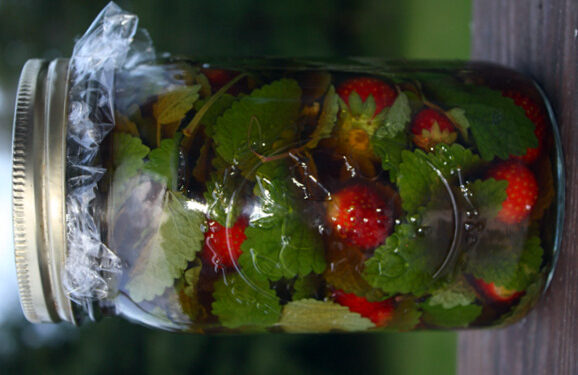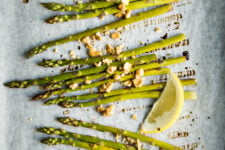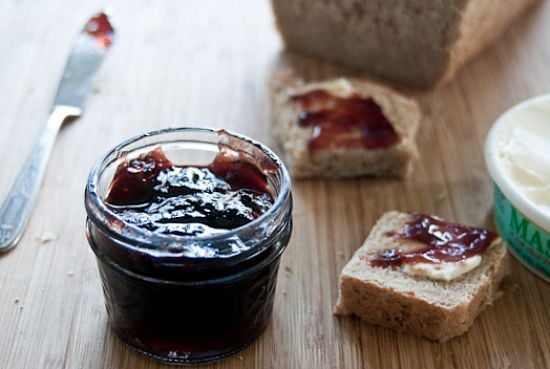I love preserving in vinegar. Vinegar is an acid, and acids have the ability to draw out minerals. If you add some vinegar in the liquid when you make stocks with bones, this will help bring the minerals from the bones into the broth; a similar thing happens when you soak mineral-rich herbs/wild plants in vinegar.
I knew I would make something with herbs, because consuming herbal vinegar made with culinary herbs or wild plants is a very healthy practice. I chose to make a vinegar featuring lemon balm, and I added some of my garden strawberries, as well.
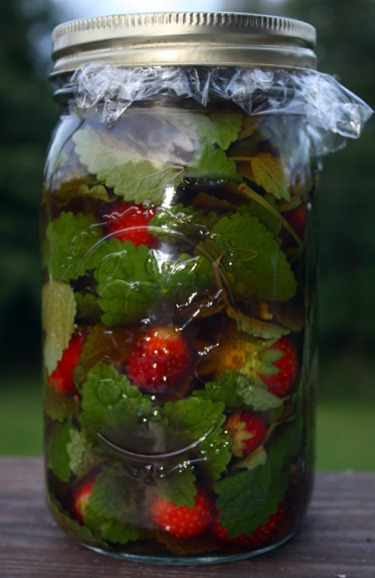
Lemon balm (Melissa officianalis) is is an herb that I love. It’s in the mint family and has a reputation for being invasive like mint, but I’ve found it to be very easy to grow and no trouble at all.
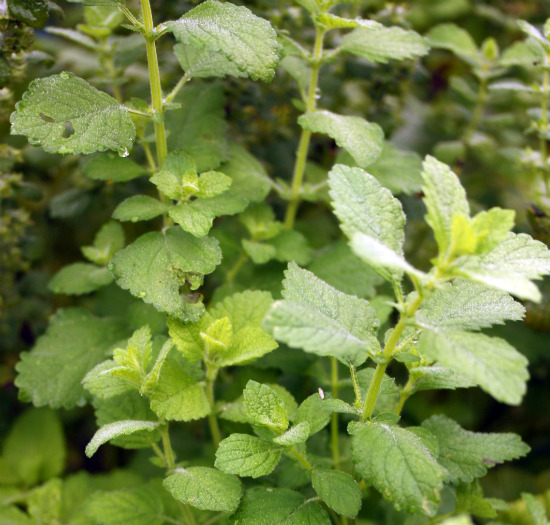
Lemon balm is known as a “nervine” (meaning it helps to soothe the nerves). It’s also good for your digestion, and has anti-bacterial activity.
But you don’t have to use lemon balm. I’ve been making herbal vinegars with plants such as burdock, nettles, dandelion, chickweed, lamb’s quarters, red clover, violet, and even pine needles (renowned herbalist Susun Weed frequently praises pine needle vinegar), for years. All of these plants are extremely nutritious; they are high in calcium, magnesium, and iron, and these minerals are extracted into the vinegar in which they are soaked.
You could also use common culinary herbs, edible flowers, fresh or dried fruit: whatever you want to use to provide flavor and nutrition to your vinegar.
You might choose any single herb or combination of herbs such as basil, dill, mint, lemon balm, rosemary, tarragon, thyme, oregano, and/or sage. All of these taste great and have some health-enhancing properties, as well.
Chives, chilies, garlic, ginger, and shallots are also possibilities: all of these impart wonderful flavor on their own or in a combination, and they too are very healthy.
Fruits can also be used. Berries, fresh or dried, are particularly nice, and do well when combined with some lemon balm or mint. Edible flowers such as bee balm and nasturtium are also nice choices.
The first thing you need to make an herbal vinegar is a glass jar (I buy mason jars by the box; they are inexpensive and this guarantees I always have them around to make recipes like this). You could also use old pickle or spaghetti sauce or similar jars that have been cleaned very well. Keep in mind that vinegar eats away at metal so you can’t close these up with a metal lid unless you put a layer of plastic wrap secured with a rubber band underneath. You could also use jars with plastic lids or ones that have a cork. Vinegar is an excellent preservative and this project is pretty much foolproof. There is no need to sterilize the jars.
Then, you will need some plant material, something from one of the lists above.
After you have readied your jars and chosen what you are going to preserve, you need some vinegar. If you are making a large quantity of flavored vinegars, I recommend purchasing inexpensive vinegars such as wine or apple cider varieties by the gallon to use as your base. I personally use raw organic apple cider vinegar that I buy by the gallon.
But you could also use red or white wine vinegar, rice vinegar, balsamic vinegar, or sherry vinegar. Just don’t use white vinegar as it is highly processed.
[cft format=0]
Flavored vinegars keep very well, and it’s nice to have a bunch of them on hand to make marinades and dressings more interesting; they also make nice gifts.
Use your vinegars in salad dressings, or just drizzle them on to your greens and grains, soups, etc. This helps make the minerals in your foods more available to your body. You can even have some (1 tablespoon or so) in warm water with a bit of raw honey or maple syrup as a tonic- this makes a nice substitute for tea or coffee in the morning or afternoon, believe it or not!
For more information, Going Wild in the Kitchen: The Fresh & Sassy Tastes of Vegetarian Cooking has a great chapter on flavored oils and vinegars.
This post is linked to the 7th edition of Simple Lives Thursday!
How to Preserve Culinary Herbs, Wild Plants, and/or Fruit in Vinegar
Instructions
- 1. Clean and chop up whatever plant material you are using (the amount of plant material you'll need depends on the size of your jar(s). If using berries, they don't need to be chopped. Fill up your jar(s) with your chopped herbs/plants. If you are using fresh plants, you should pack the jar(s) full (squish as much plant material as you can in there); if using berries or dried plants, just fill your jar half way.
- 2. Pour in your vinegar, cap your jar, and let steep for 2-8 weeks in a dark cabinet (if using fresh fruit, 2 weeks is enough; the other plants can sit for 6-8 weeks). Check your vinegar every few days and see if the vinegar is getting low- add some to cover the plant material if needed.
- 3. When the recommended time has passed, strain out the plants (or eat them!) and label your vinegar so you know what you used to make it (honestly this is a good idea- don't rely on your memory. If you are anything like me, months from now you'll stare at all of your different bottles and you'll have no idea what's in them!). Put your vinegar(s) into pretty jar(s) if you are giving as a gift and are so inclined.
- 4. Put the date on your label too so you'll know when it's no longer good. These keep for 1-2 years, but after that you should probably make a fresh batch.

